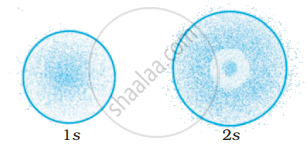Advertisements
Advertisements
प्रश्न
The electronic configuration of oxygen is written as 1s2 2s2 \[\ce{2p^2_{{x}}}\] \[\ce{2p^1_{{y}}}\] \[\ce{2p^1_{{z}}}\] and not as 1s2 2s2 \[\ce{2p^2_{{x}}}\], \[\ce{2p^2_{{y}}}\] \[\ce{2p^0_{{z}}}\], Explain.
उत्तर
- According to Hund’s rule of maximum multiplicity “Pairing of electrons in the orbitals belonging to the same subshell does not occur unless each orbital belonging to that subshell has got one electron each.”
- Oxygen has 8 electrons. The first two electrons will pair up in the 1s orbital, the next two electrons will pair up in the 2s orbital and this leaves 4 electrons, which must be placed in the 2p orbitals.
- Each of the three degenerate p-orbitals must get one electron of parallel spin before anyone of them receives the second electron of opposite spin. Therefore, two p orbitals have one electron each and one p-orbital will have two electrons.
Thus, the electronic configuration of oxygen is written as 1s2 2s2 \[\ce{2p^2_{{x}}}\] \[\ce{2p^1_{{y}}}\] \[\ce{2p^1_{{z}}}\] and not as 1s2 2s2 \[\ce{2p^2_{{x}}}\], \[\ce{2p^2_{{y}}}\] \[\ce{2p^0_{{z}}}\]
APPEARS IN
संबंधित प्रश्न
Choose the correct option.
Principal Quantum number describes -
Give the names of quantum numbers.
State and explain Pauli’s exclusion principle.
State Hund’s rule of maximum multiplicity with a suitable example.
Explain the anomalous behaviour of chromium.
Write orbital notations for the electron in orbitals with the following quantum numbers.
n = 4, l = 2
Write condensed orbital notation of electronic configuration of the following element:
Oxygen (Z = 8)
Draw shapes of 2p orbitals.
If n = 3, what are the quantum number l and m?
Which mineral among the following contains vanadium in it?
The three electrons have the following set of quantum numbers:
X = 6, 1, −1, `+1/2`
Y = 6, 0, 0, `+1/2`
Z = 5, 1, 0, `+1/2`
Identify the CORRECT statement.
Which one of the following is NOT possible?
The probability density plots of 1s and 2s orbitals are given in Figure:

The density of dots in a region represents the probability density of finding electrons in the region.
On the basis of above diagram which of the following statements is incorrect?
Which of the following properties of atom could be explained correctly by Thomson Model of atom?
The number of radial nodes for 3p orbital is ______.
Orbital angular momentum depends on ______.
Which of the following statements concerning the quantum numbers are correct?
(i) Angular quantum number determines the three dimensional shape of the orbital.
(ii) The principal quantum number determines the orientation and energy of the orbital.
(iii) Magnetic quantum number determines the size of the orbital.
(iv) Spin quantum number of an electron determines the orientation of the spin of electron relative to the chosen axis.
Nickel atom can lose two electrons to form \[\ce{Ni^{2+}}\] ion. The atomic number of nickel is 28. From which orbital will nickel lose two electrons.
The arrangement of orbitals on the basis of energy is based upon their (n + l) value. Lower the value of (n + l), lower is the energy. For orbitals having same values of (n + l), the orbital with lower value of n will have lower energy.
Based upon the above information, arrange the following orbitals in the increasing order of energy.
5f, 6d, 7s, 7p
The electronic configuration of valence shell of Cu is 3d104s1 and not 3d94s2. How is this configuration explained?
What is the difference between the terms orbit and orbital?
Match the following
| (i) Photon | (a) Value is 4 for N shell |
| (ii) Electron | (b) Probability density |
| (iii) ψ2 | (c) Always positive value |
| (iv) Principal quantum number n | (d) Exhibits both momentum and wavelength |
Match species given in Column I with the electronic configuration given in Column II.
| Column I | Column II |
| (i) \[\ce{Cr}\] | (a) [Ar]3d84s0 |
| (ii) \[\ce{Fe^{2+}}\] | (b) [Ar]3d104s1 |
| (iii) \[\ce{Ni^{2+}}\] | (c) [Ar]3d64s0 |
| (iv) \[\ce{Cu}\] | (d) [Ar] 3d54s1 |
| (e) [Ar]3d64s2 |
Choose the INCORRECT statement
Which of the following is not the permissible arrangement of electrons in an atom?
Which of the following element do not follow Aufbau principle?
